View in other NatureServe Network Field Guides
NatureServe
Montana
Utah
Wyoming
Idaho
Wisconsin
British Columbia
South Carolina
Yukon
California
New York
Meadow Hawkweed - Hieracium caespitosum
Other Names:
Hieracium pratense [misapplied], Pilosella caespitosa, Hieracium floribundum*
State Rank Reason (see State Rank above)
Hieracium caespitosum is part of the Meadow Hawkweed complex. Plants are native to Europe and introduced to most of the non-arid areas of temperate North America (Lesica et al. 2012). A conservation status rank is not applicable (SNA) because the plant is an exotic (non-native) in Montana that is not a suitable target for conservation activities.
General Description
PLANTS: Perennial forbs with erect stems from 20-80 cm tall that are rhizomatous and sometimes have short stolons. Rhizomes have fibrous-roots. Stems are single (simple). Stems have stiff hairs (hirsute) of 1-4+ mm that may become shorter and stipitate-glandular upwards. Upper stems might also have stellate (star-like) hairs. Sources: FNA 2006; Lesica et al. 2012.
LEAVES: 3-8 basal leaves and 0-2 stem leaves. Basal leaves 3-15 cm long, petiolate, blades lanceolate to oblanceolate, margins entire to obscurely denticulate, and tips rounded to acute. Leaf surfaces with stiff hairs (hirsute) of 1-3+ mm long and stellate-pubescent.
INFLORESCENCE: More-or-less umbelliform or in congested corymbiform arrays. Yellow flower heads of 5 to 25, clustered, and pedunculate with stellate pubescence and stipitate-glandular hairs. The involucres are campanulate, 6–8 mm high. The involucral bracts (phyllaries) are linear-lanceolate with scarious-margins and acute to acuminate tips, stellate-hairy, hirsute, and densely black setose-glandular. Flower heads composed of 25 to 50 florets with yellow petals, 3–10 mm long. The pappus is of white bristles occurring in 1-series and 4-6 mm long. Fruits (cypselae) are columnar, about 1.5 mm long, and retain the tuft of bristles (pappus).
Phenology
Flowering May to August (FNA 2006).
Diagnostic Characteristics
Montana has about 4 native and 3 exotic Hawkweeds. Their species identification can be complex and confusing because species interbreed to form hybrids and some populations are apomictic (see Reproductive Characteristics).
Hieracium caespitosum,
Hieracium praealtum,
Hieracium piloselloides, and
Hiercium gracile have yellow flower heads while
Hieracium aurantiacum is the only Hawkweed with red-orange flower heads.
Meadow Hawkweed (
Hieracium caespitosum) has florets with pappus bristles in 1 series (single ring of bristles). Its upper stems and involucres have dense glandular setae (hairs), but
Hieracium praealatum has scattered glandular setae mixed in with non-glandular setae (Lesica et al. 2012).
Hieracium caespitosum has short stolons (when they are present).
Hieracium praealatum is more likely to have stolons and when present they are longer and slender.
Kingdevil Hawkweed (
Hieracium praealtum) Villers ex Gochnat has leaves with lower surfaces that have stellate (star-shaped) hairs (FNA 2006). In Lesica’s treatment in the
Manual of Montana Vascular Plants (2012) our plants appear to better fit the description of
Hieracium praealtum Villers ex Gochnatthen than of
H. piloselloides Vill. or
H. floribundum Wimm. & Grab. However, the Strother’s treatment in the
Flora of North America (2006) does not include
Hieracium praealtum Villers ex Gochnat, but does recognize it might merit taxonomic recognition.
Tall Hawkweed (
Hiercium piloselloides) has leaves (upper and lower surfaces) that are
lack both hair types of long, stiff hairs (piloso-hirsute) and stellate (star-like) hairs (FNA 2006). Leaves are glabrous or have one long, stiff hairs on the midribs and margins.
Alpine Hawkweed (
Hiercium gracile)is a native plant of the subalpine and alpine habitats. Its florets have 2 series of pappus bristles. Plants also tend to be less than 30 cm tall.
* The type specimen for
Hieracium floribundum (Pale Hawkweed) is likely a hybrid between
Hieracium caespitosum and
Hieracium lactucella (FNA 2006); therefore, the name should not be applied to specimens in Montana.
Species Range
Montana Range
Range Descriptions
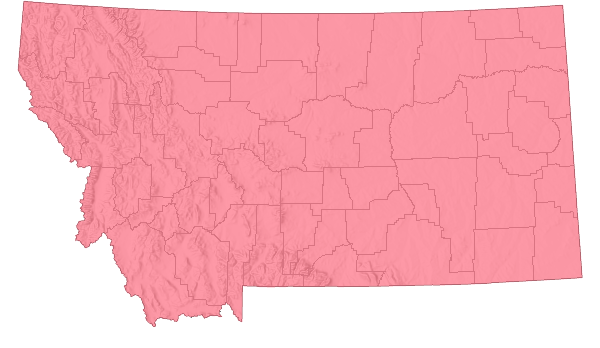
 Non-native
Non-native
Range Comments
Meadow Hawkweed occurs in the northern, central, and eastern portions of Europe and is native to the foothills of the Alps (Wilson and Callihan in Sheley and Petroff 1999). Plants came into North America around 1828. In the Pacific Northwest it was first documented in 1969 from Pend Orielle County, Washington (www.pnwherbaria.org).
For maps and other distributional information on non-native species see:
Nonindigenous Aquatic Species Database from the U.S. Geological Survey
Invasive Species Habitat Tool (INHABIT) from the U.S. Geological Survey
Invasive Species Compendium from the Centre for Agriculture and Bioscience International (CABI)
EDDMapS Species Information EDDMapS Species Information
Observations in Montana Natural Heritage Program Database
Number of Observations: 8740
(Click on the following maps and charts to see full sized version)
Map Help and Descriptions
Relative Density
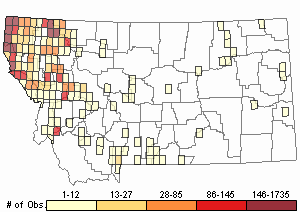
Recency
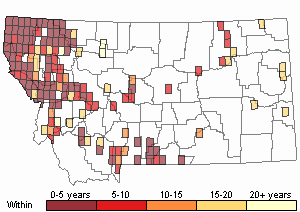

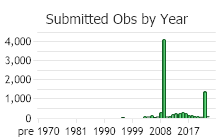
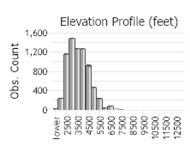 (Observations spanning multiple months or years are excluded from time charts)
(Observations spanning multiple months or years are excluded from time charts)
Habitat
Grasslands and along roadsides from valleys to montane (Lesica et al. 2012).
Ecology
The loss of biodiversity is the most prevalent threat posed by Meadow Hawkweed.
HABITAT VULNERABILITY
In their native habitats of northern and central Europe, Meadow and Orange Hawkweeds are species of pastures, roadsides, abandoned fields, and meadows that form small populations (Skalinksa 1967). In the northern U.S. these plants appear to pose the greatest threat to cooler, sub-humid to humid habitats. They have invaded moist pastures, forest meadows, abandoned fields, clearcuts, and roadsides from valleys to montane (Skalinksa 1967; Lesica et al. 2012). Once established plants quickly grow into a matt of dense rosettes (Wilson and Callihan
in Sheley and Petroff 1999). Consequently, elk habitat, recreational areas, and pristine mountain meadows are especially susceptible to invasion (Wilson and Callihan
in Sheley and Petroff 1999). Drier rangeland habitats are not suspected of being vulnerable (Wilson and Callihan
in Sheley and Petroff 1999). Meadow and Orange Hawkweeds apparently do not survive in annually-tilled cropland (Wilson and Callihan
in Sheley and Petroff 1999).
NUTRIENT VALUE
Meadow Hawkweed leaves and flower buds are eaten by livestock, deer, and elk (Wilson and Callihan
in Sheley and Petroff 1999). The protein content of leaves ranged from 7% (similar to low-quality cured timothy hay) to 11% (equal to high-quality grass hay) (Callihan et al. 1995). The digestibility of Hawkweed leaves was 74% which is higher than the 60-65% found in pasture grass. Flowers were moderately digestible at 64% and contained twice (18%) the amount of protein as the leaves.
POLLINATORS The following animal species have been reported as pollinators of this plant species or its genus where their geographic ranges overlap:
Bombus ternarius,
Bombus terricola,
Bombus bohemicus, and
Bombus flavidus (Heinrich 1976, Colla and Dumesh 2010).
Reproductive Characteristics
Meadow Hawkweed plants reproduce by seed, rhizomes, and stolons.
From the rosette, plants produce 1 flowering stem. Plants are often apomictic, that is reproducing from asexually produced seeds (FNA 2006). Apomictic reproduction creates morphological variants that perpetuate at population and regional levels (FNA 2006). This can make identifying hybrids difficult. Very few seeds are produced sexually through pollination and out-crossing (Wilson and Callihan in Sheley and Petroff 1999). Flowering in a related species, Hieracium floribundum, was found to occur upon exposure to a specific amount and quality of light (Wilson and Callihan in Sheley and Petroff 1999).
Mature seeds can germinate immediately after dispersal and be viable for up to seven years (Wilson and Callihan in Sheley and Petroff 1999). In a study of Hieracium floribundum only 1% of new plants were born from seeds (Thomas and Dale 1974). The study also found that 80% of the seeds dispersed within the colony with only 1% of the seeds travelling greater than 30 feet (10 meters) from the patch. Another study found that seedlings that germinated in spring had better survival rates than those germinating in summer or winter (Johnson and Thomas 1978).
Management
PREVENTION [Adapted from Wilson and Callihan
in Sheley and Petroff 1999]
Successful management seeks to prevent infestations and detect them before the patch spreads vegetatively. Large infestations are difficult to control. Using multispectral, digital images may identify infestations in remote areas better than visual surveys over large areas (refer to Carson et al. 1995).
CHEMICAL CONTROL [Adapted from Wilson and Callihan
in Sheley and Petroff 1999]
The Phenoxy-type herbicides (2,4-D, clopyralid, and picloram) are effective in controlling orange and meadow Hawkweeds when applied to the rosette stage and used with a surfactant. The herbicide type and concentration, timing of chemical control, soil properties, and other factors will determine its effectiveness and impact to non-target species. Strict adherence to application requirements defined on the herbicide label will reduce risks to human and environmental health. Many herbicides must be applied by applicators with an Aquatic Pest Control license. Consult your County Extension Agent and/or Weed District for more information on herbicidal control.
Researchers at the University of Idaho found more than a 50% control of Hawkweed using
clopyralid at the rate of 0.5 lb ai/ac. A similar control was found using
picloram at the rate of 0.2-0.5 lb ai/ac.
A combination of fertilizers and herbicides used where Hawkweed is mixed with perennial grasses, legumes, and other forbs can contain spreading. Fertilizer treatments reduced Hawkweed density and vigor in the U.S., Canada, and New Zealand. Depending upon soil productivity and grass condition, fertilizers can promote the growth of desirable plants which may become competitive enough to suppress Hawkweed growth.
CULTURAL & GRAZING CONTROLS [Adapted from Wilson and Callihan
in Sheley and Petroff 1999]
Hand-pulling and
mowing are not effective control measures. Physical disturbance to meadow Hawkweed severs roots, stolons, and/or rhizomes causing the plant to further spread. Mowing may remove flowering stems and reduce seed production but will not hinder growth by the stolons or rhizomes. Soils disturbed by livestock, rodents, or people can also enhance the plant to spread.
BIOCONTROL [Adapted from Wilson and Callihan
in Sheley and Petroff 1999]
In 1995 the USDA Agricultural Research Service in Bozeman, Montana began to develop the feasibility of a biological control program for Orange and Meadow Hawkweeds. However, biological control for these plants has not yet successfully been developed in the U.S.
Useful Links:Montana Invasive Species websiteMontana Biological Weed Control Coordination ProjectMontana Department of Agriculture - Noxious WeedsMontana Weed Control AssociationMontana Weed Control Association Contacts Webpage.
Montana Fish, Wildlife, and Parks - Noxious WeedsMontana State University Integrated Pest Management ExtensionWeed Publications at Montana State University Extension - MontGuides
Stewardship Responsibility
Threats or Limiting Factors
The loss of biodiversity is the most prevalent threat posed by Meadow Hawkweed.
References
- Literature Cited AboveLegend:
 View Online Publication
View Online Publication Callihan, R.H., C.W. Hunt, and B.B. Marsh. 1995. Yellow Hawkweed forage quality, Res. Prog. Rep. West. Soc. Weed Sci.
Callihan, R.H., C.W. Hunt, and B.B. Marsh. 1995. Yellow Hawkweed forage quality, Res. Prog. Rep. West. Soc. Weed Sci. Carson, H.W., L.W. Lass, and R.H. Callihan. 1995. Detection of Yellow Hawkweed with high resolution digital images. Weed Technol. 9: 477-483.
Carson, H.W., L.W. Lass, and R.H. Callihan. 1995. Detection of Yellow Hawkweed with high resolution digital images. Weed Technol. 9: 477-483. Colla, S.R. and S. Dumesh. 2010. The bumble bees of southern Ontario: notes on natural history and distribution. Journal of the Entomological Society of Ontario 141:39-68.
Colla, S.R. and S. Dumesh. 2010. The bumble bees of southern Ontario: notes on natural history and distribution. Journal of the Entomological Society of Ontario 141:39-68. Flora of North America Editorial Committee. 2006. Flora of North America North of Mexico. Vol. 19. Magnoliophyta: Asteridae, part 6: Asteraceae, part 1. Oxford Univ. Press, New York. xxiv + 579 pp.
Flora of North America Editorial Committee. 2006. Flora of North America North of Mexico. Vol. 19. Magnoliophyta: Asteridae, part 6: Asteraceae, part 1. Oxford Univ. Press, New York. xxiv + 579 pp. Johnson, C.D., and A.G. Thomas. 1978. Recruitment and survival of seedlings of perennial Hieracium species in a patchy environment. Can. J. Bot. 56: 572-580.
Johnson, C.D., and A.G. Thomas. 1978. Recruitment and survival of seedlings of perennial Hieracium species in a patchy environment. Can. J. Bot. 56: 572-580. Lesica, P., M.T. Lavin, and P.F. Stickney. 2012. Manual of Montana Vascular Plants. Fort Worth, TX: BRIT Press. viii + 771 p.
Lesica, P., M.T. Lavin, and P.F. Stickney. 2012. Manual of Montana Vascular Plants. Fort Worth, TX: BRIT Press. viii + 771 p. Sheley, Roger, and Janet Petroff. 1999. Biology and Management of Noxious Rangeland Weeds. Oregon State University Press, Corvallis, Oregon.
Sheley, Roger, and Janet Petroff. 1999. Biology and Management of Noxious Rangeland Weeds. Oregon State University Press, Corvallis, Oregon. Skalinska, M. 1967. Cytological analysis of some Hieracium species, subgenus Pilosella, from mountains of southern Poland. Acta. Biol. Cracov. Ser. bot. 10: 128-141.
Skalinska, M. 1967. Cytological analysis of some Hieracium species, subgenus Pilosella, from mountains of southern Poland. Acta. Biol. Cracov. Ser. bot. 10: 128-141. Thomas, A.G., and H.M. Dale. 1974. Zonation and regulation of old pasture populations of Hieracium floribundum. Can. J. Bot. 52:1451-1458.
Thomas, A.G., and H.M. Dale. 1974. Zonation and regulation of old pasture populations of Hieracium floribundum. Can. J. Bot. 52:1451-1458.
- Additional ReferencesLegend:
 View Online Publication
View Online Publication
Do you know of a citation we're missing? Lesica, P., M.T. Lavin, and P.F. Stickney. 2022. Manual of Montana Vascular Plants, Second Edition. Fort Worth, TX: BRIT Press. viii + 779 p.
Lesica, P., M.T. Lavin, and P.F. Stickney. 2022. Manual of Montana Vascular Plants, Second Edition. Fort Worth, TX: BRIT Press. viii + 779 p.
- Web Search Engines for Articles on "Meadow Hawkweed"





